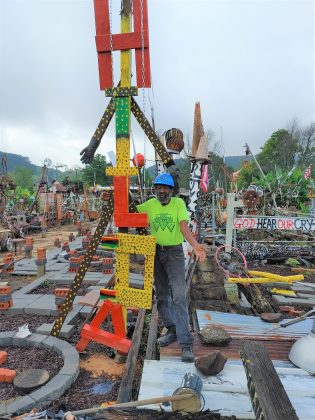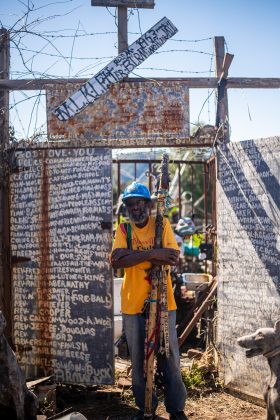
By Ryan Michaels
The Birmingham Times
Joe Minter is among several celebrated Southern Black artists, including Thornton Dial and Lonnie Holley, who were part of a group publicized nationally by William Arnett, the late art collector and founder of the arts nonprofit Souls Grown Deep.
Minter, 78, is a sculptor and longtime resident of Woodland Park, a neighborhood within Birmingham’s North Titusville community. His property houses the “African Village in America,” which he started growing in 1989. Minter’s yard features a variety of sculptures that often deal with racism and display reverence for African ancestors and spirituality.
Alabama native Dial, who died in McCalla in 2016, worked in media, including sculpture, painting, and drawing, often combining his skills in his pieces. His work has been featured at the Whitney Museum of American Art in New York City, the High Museum of Art in Atlanta, Georgia, and at the Museum of Fine Arts in Houston, Texas, among other museums. In addition, Dial’s work was showcased in a 2011 Time magazine profile.
Holley, 71, formerly of the Birmingham area, is a visual artist and musician. Within visual art, his primary work features found-object sculptures and the environments of these pieces, similar to Minter’s work.
Since 2012, Holley also records experimental music. His work has been on display at the High Museum of Art in Atlanta, as well as the Smithsonian Museum of American Art and the White House in Washington, D.C., among other places. Holley found Minter’s “African Village in America” per a recommendation from his daughter and has visited the site several times. Holley spent many years in and near Birmingham but left Alabama altogether after feeling poorly treated by his neighbors in Harpersville.
Minter said Holley’s absence has given him more responsibility as an artist in the area.
“[People] ran Lonnie Holley out of here, and I’m the last standing pole in a crowd of confusion, but I ain’t by myself though,” Minter said. “I got a hundred thousand ancestors feeding me all the emotions and everything that’s been done to me, and I’m pledging right now not to let my ancestors down, not to let my next generation [down].”
In addition showcasing his works at the “African Village in America,” Minter was recently featured in a New York Times article, “Saving the Artwork of the South: Deep Investment, and a Drone,” and his sculptures have been showcased across the United States in places like the Whitney Museum of Art and the Metropolitan Museum of Art in New York City, as well as the Smithsonian American Art Museum in Washington, D.C. Currently, the Birmingham Museum of Art has one piece from Minter currently on display: “’63 Foot Soldiers.”
This summer, the University of Alabama used advanced geographic technology to document every square foot of the African Village, a project that will enable viewers to experience the installation in virtual reality. Meanwhile, thousands of visitors from around the world have visited Minter’s yard collection and signed a guest book that he keeps memorialize their trips.
Minter’s “African Village in America” is located at 931 Nassau Ave. SW, Birmingham, Alabama 35211 facebook.com/joeminterafricanvillage















